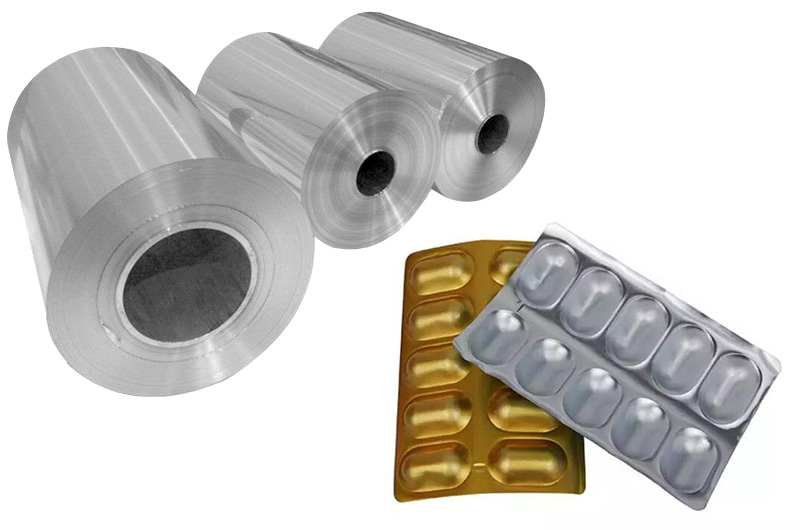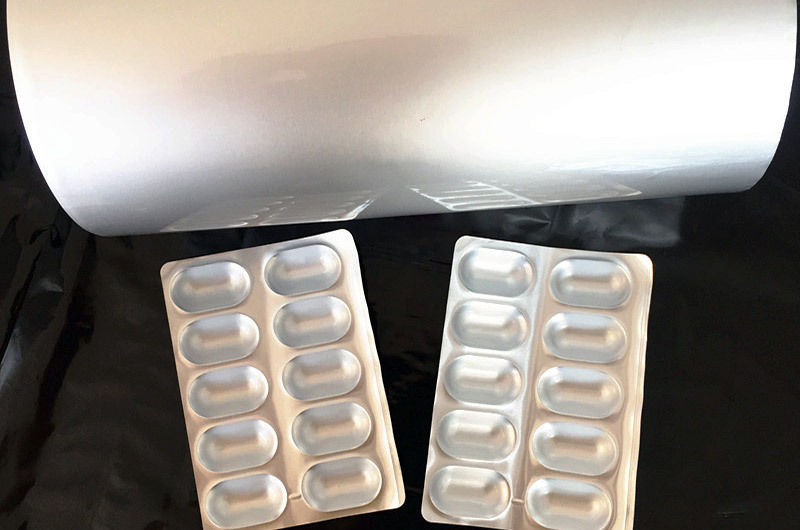- Cold Forming Blister Foil the Key Components
- Aluminum foil specifications for cold forming pharmaceutical foils
- Cold forming medicinal aluminum foil processing requirements
- Cold formed blister aluminum foil typical aluminum alloy
- Advantages of cold forming blister foil
- Cold formed blister aluminum foil quality control
- Cold Forming Blister Foil Manufacturing process
- Conclusion
The pharmaceutical industry attaches great importance to packaging materials to ensure the safety, effectiveness and stability of medicines. Cold-formed blister foils have gained widespread recognition for their ability to meet these stringent requirements.
Cold-formed blister foil is a specialty packaging material widely used in the pharmaceutical industry for primary packaging of tablets and capsules. This type of packaging is unique in its manufacturing process in that the aluminum foil is not heated during the forming process, giving rise to the term "cold forming."

Cold-formed blister packaging is a specialized form of pharmaceutical packaging that involves the use of a laminate consisting of aluminum foil sandwiched between polyvinyl chloride (PVC) and nylon (oPA) films. This unique packaging solution is created through a process called dry bond lamination technology, and the resulting material is called cold-formed blister laminate. The distinguishing feature of this process is that the laminate is pressed into the mold by stamping at room temperature, without the need for heating. Plastic films are often used as molding materials.
Cold Forming Blister Foil the Key Components
1. Aluminum foil
- Located in the middle layer of the laminate.
- Provides a barrier against moisture, gas and light.
- Provides structural integrity during cold forming.
2. Polyvinyl chloride (PVC) film
- Forms the outer layer of the laminate.
- Provide transparency for product visibility.
- Provides rigidity and protection.
3. Nylon (oPA) film
- Located between aluminum foil and PVC film.
- Enhances the mechanical properties of laminates.
- Contributes to overall barrier properties.
Aluminum foil specifications for cold forming pharmaceutical foils
| Alloy | 8021/8079 | |
|---|---|---|
| Material State | O, H14, H16, H18, etc. | |
| Thickness (mm) | 0.014 - 0.2 | |
| Width (mm) | 100 - 1600 | |
| Length (mm) | Custom (C) | |
| Typical Products | Pharmaceutical tablets, pills, capsule packaging | |
Cold forming medicinal aluminum foil processing requirements
- 1. The plate shape is flat.
- 2. The board surface has strict requirements, and there are no black oil spots, scratches, small black threads, bright lines, roller printing uneven spots, mosquitoes, etc.
- 3. If there are no holes, they must be discarded if found.
- 4. Trimming quality, no burrs, tower shapes, layer channeling, ruffles, flanging, and concave and convex lighting phenomena.
- 5. The packaging is moisture-proof and avoids oxidation.
Cold stamped aluminum overcomes the shortcomings of conventional medicinal PVC hard sheets and PP hard sheets in moisture resistance, gas isolation, light protection, thermal stability, etc. It is a kind of product that isolates various gases and blocks light radiation. Blister-type materials for pharmaceutical packaging can effectively extend the shelf life of pharmaceuticals and can be used as pharmaceutical packaging materials in extreme (high/low temperature) environments.
Cold formed blister aluminum foil typical aluminum alloy
A variety of aluminum alloys are commonly used to produce cold-formed blister foils for pharmaceutical packaging. The two most popular alloys are 8021 and 8079. Each alloy has specific properties that make it suitable for specific applications in the pharmaceutical industry.
8021 Aluminum Foil Cold Forming Blister Pharmaceutical Packaging
feature:
- High Tensile Strength: Alloy 8021 has excellent tensile strength, allowing it to withstand the mechanical stresses involved in the cold forming process. This property ensures that the foil maintains its integrity during manufacturing and subsequent processing.
- Good formability: The alloy has good formability, making it easy to shape and shape during cold forming. This feature is critical for creating complex blister designs that accommodate a wide range of pharmaceutical products.
- Temperature Resistance: Alloy 8021 can withstand the extreme temperatures encountered during cold forming without compromising its structural integrity. This makes it ideal for pharmaceutical packaging applications where temperature changes may occur.
applIcation:
- Tablets and Capsules: Alloy 8021 is commonly used in blister packaging of tablets and capsules due to its ability to form complex shapes that provide effective protection for individual doses.
- Moisture and light-sensitive drugs: The barrier properties of 8021 alloy make it an ideal choice for packaging drugs that are moisture- and light-sensitive, ensuring the stability and efficacy of the drugs.

8079 Aluminum Foil Cold Forming Blister Pharmaceutical Packaging
feature:
- Enhanced Flexibility: Alloy 8079 is known for its enhanced flexibility, allowing it to adapt to irregular shapes and contours. This feature facilitates the production of blister packs with complex designs.
- High formability: Similar to Alloy 8021, 8079 is highly formable and suitable for cold forming processes. This enables the production of blister packs with tight seals and precise shapes.
- Corrosion Resistance: Alloy 8079 is corrosion-resistant, ensuring that the blister foil maintains its integrity over time without compromising the quality of the encapsulated pharmaceutical product.
application:
- Specialty pharmaceuticals: Because of its flexibility and formability, Alloy 8079 is often used for packaging specialty pharmaceuticals that require unique blister shapes and configurations.
- Biological products and sensitive formulations: The corrosion-resistant properties of 8079 alloy make it suitable for packaging biological products and formulations that are sensitive to environmental factors, providing an effective barrier against moisture and vapor.
Cold-formed blister aluminum foil pharmaceutical packaging is mainly used for aluminum-plastic blister packaging of pharmaceutical tablets, capsules, pills, etc. It can also be used for blister packaging of food and health care products. Cold formed aluminum foil can be heat sealed with pharmaceutical ptp aluminum foil.
Advantages of cold forming blister foil
1. Barrier performance
One of the main advantages of cold formed blister foil is its excellent barrier properties. The aluminum layer can effectively block moisture, oxygen and light, preventing drug degradation. This barrier helps keep the drug stable and effective over a longer period of time.
2. Customizable shapes
Cold forming can create blister packs with complex and customizable shapes. This is particularly beneficial for pharmaceutical products that may have unique shapes or require specific packaging configurations. The ability to adapt to a variety of forms and sizes enhances the flexibility of cold-formed blister foils for different drug formulations.
3. Anti-tampering
Cold-formed blister packaging is tamper-evident, ensuring the integrity of the pharmaceutical product. Once the foil surrounding the medication is formed, it is difficult to tamper with the contents without leaving obvious signs of interference. This feature is critical for consumer safety and compliance with regulatory requirements.
4. Extend shelf life
Aluminum's impermeability to gases and moisture helps extend the shelf life of pharmaceutical products. Cold-formed blister foil helps protect drugs from environmental factors that could compromise their stability, ensuring they remain effective from production to consumption.
5. Printability and branding
Aluminum’s smooth surface allows for high-quality printing, allowing manufacturers to add basic information such as dosage instructions, expiration dates and branding to blister packs. This enhances product visibility, facilitates identification, and provides important information to healthcare professionals and consumers.
6. Lightweight and cost-effective
Aluminum is a lightweight material that makes cold-formed blister packs easy to handle and ship. The weight reduction also contributes to cost-effectiveness in shipping and distribution. Additionally, aluminum is recyclable, in line with the pharmaceutical industry’s sustainability goals.
7. Chemical compatibility
Aluminum has excellent chemical compatibility with a variety of pharmaceutical formulations. It does not react with most pharmaceutical compounds, ensuring that packaging materials do not introduce impurities or negatively impact the stability of the drug.
8. Easy to distribute
The blister format of cold-formed aluminum foil facilitates easy dispensing and management of pharmaceutical products. Each unit dose is individually sealed, allowing precise control of dosage and minimizing the risk of contamination or spillage.
9. Regulatory Compliance
Cold formed blister foil is designed to meet the stringent regulatory requirements for pharmaceutical packaging. It complies with industry standards and guidelines to ensure the safety, effectiveness and quality of packaged medicines.
In summary, cold-formed blister foil has become an integral part of pharmaceutical packaging due to its numerous advantages. From providing a protective barrier to allowing customization of shapes and ensuring tamper resistance, this packaging material plays a vital role in maintaining the integrity and effectiveness of pharmaceutical products.
The properties of aluminum combined with the cold forming process provide the pharmaceutical industry with reliable and versatile packaging solutions.
Cold formed blister aluminum foil quality control
Ensuring the quality and compliance of cold-formed blister foils in pharmaceutical packaging is critical. This section discusses the strict quality control measures implemented during the manufacturing process and the industry standards and regulations governing pharmaceutical packaging materials.
- Material inspection: Ensure aluminum alloy meets requirements and check for surface defects.
- Process Monitoring: Control parameters during cold forming, coating and printing processes to ensure consistency.
- Dimensional Control: Monitor thickness and verify die cuts are accurate.
- Visual inspection: Detect and resolve defects such as pinholes and irregularities.
- Mechanical property testing: Perform tensile strength and elongation tests.
- Barrier Performance Test: Verifies the foil's ability to protect against moisture and gases.
- Print quality and legibility: Check the quality and legibility of printed information.
- Packaging integrity: Evaluates seal strength and tamper resistance.
- Regulatory Compliance: Maintain documentation to comply with industry standards and regulations.
- Continuous improvement: Establish a feedback mechanism, conduct reviews, and implement corrective measures.
- Environmental considerations: Optimize processes for recyclability and sustainability.
Cold Forming Blister Foil Manufacturing process
1. Material preparation
Aluminum foil, PVC membrane and nylon membrane are selected based on their specific properties and compatibility.
These materials are prepared in roll form for subsequent lamination processes.
2. Dry bonding lamination
Dry adhesive lamination involves applying adhesive without heat.
Three layers of aluminum foil, nylon film, and PVC film are bonded together using an adhesive to form a laminate.
3. Sheet formation
The laminate is then converted into sheets of the required size for the blister pack.
4. Cold forming
The cold forming process involves using a stamping machine to press laminate into a mold.
The absence of heat during the process is a key feature, so the term "cold forming" is retained.
The laminate takes the shape of the mold without changing the properties of the foil.
Conclusion
Cold-formed blister foil with an aluminum core revolutionizes pharmaceutical packaging. This article provides a comprehensive look at the role of aluminum and the specific aluminum alloys used in cold-formed blister foil, highlighting their impact on product integrity, safety and environmental sustainability.
